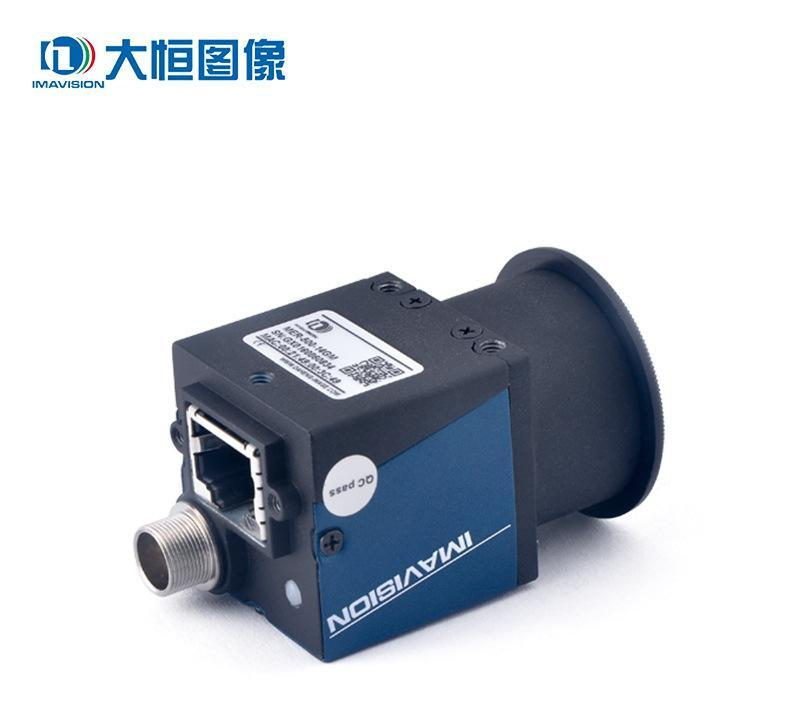
In environments where the working environment is relatively harsh and there are many interference sources, industrial cameras are generally used for visual recognition. Daheng crystal cameras are a more commonly used one. Compared with imported cameras, although they are more troublesome to use, fortunately they are cheap and have good performance indicators.
Daheng Crystal Camera provides SDK to integrate with OPENCV-type systems. It is not yet able to directly provide system-level drivers like many imported cameras. There is still a lot of information in this area. The following is extracted from the Internet. one example:
// test.cpp : 定义控制台应用程序的入口点。
//
#include "stdafx.h"
#include "GxIAPI.h"
#include "DxImageProc.h"
#include <opencv2/core/core.hpp>
#include <opencv2/imgproc/imgproc.hpp>
#include <opencv2/highgui/highgui.hpp>
#include <iostream>
using namespace std;
using namespace cv;
GX_DEV_HANDLE m_hDevice; ///< 设备句柄
BYTE *m_pBufferRaw; ///< 原始图像数据
BYTE *m_pBufferRGB; ///< RGB图像数据,用于显示和保存bmp图像
int64_t m_nImageHeight; ///< 原始图像高
int64_t m_nImageWidth; ///< 原始图像宽
int64_t m_nPayLoadSize;
int64_t m_nPixelColorFilter; ///< Bayer格式
Mat test;
//图像回调处理函数
static void GX_STDC OnFrameCallbackFun(GX_FRAME_CALLBACK_PARAM* pFrame)
{
//PrepareForShowImg();
if (pFrame->status == 0)
{
//对图像进行某些操作
/*memcpy(m_pBufferRaw, pFrame->pImgBuf, pFrame->nImgSize);
// 黑白相机需要翻转数据后显示
for (int i = 0; i <m_nImageHeight; i++) {
memcpy(m_pImageBuffer + i*m_nImageWidth, m_pBufferRaw + (m_nImageHeight - i - 1)*m_nImageWidth, (size_t)m_nImageWidth);
}
IplImage* src;
src = cvCreateImage(cvSize(m_nImageWidth, m_nImageHeight), 8, 1);
src->imageData = (char*)m_pImageBuffer;
cvSaveImage("src.jpg", src);*/
memcpy(m_pBufferRaw, pFrame->pImgBuf, pFrame->nImgSize);
// RGB转换
DxRaw8toRGB24(m_pBufferRaw
, m_pBufferRGB
, (VxUint32)(m_nImageWidth)
, (VxUint32)(m_nImageHeight)
, RAW2RGB_NEIGHBOUR
, DX_PIXEL_COLOR_FILTER(m_nPixelColorFilter)
, false);
// cv_Image->imageData = (char*)m_pBufferRGB;
// cvSaveImage("./test.bmp", cv_Image);
//test.data = m_pBufferRaw;
memcpy(test.data, m_pBufferRGB, m_nImageWidth*m_nImageHeight * 3);
imwrite("./test1.bmp", test);
namedWindow("test");
imshow("test", test);
waitKey(15);
}
return;
}
int main(int argc, char* argv[])
{
GX_STATUS emStatus = GX_STATUS_SUCCESS;
GX_OPEN_PARAM openParam;
uint32_t nDeviceNum = 0;
openParam.accessMode = GX_ACCESS_EXCLUSIVE;
openParam.openMode = GX_OPEN_INDEX;
openParam.pszContent = "1";
// 初始化库
emStatus = GXInitLib();
if (emStatus != GX_STATUS_SUCCESS)
{
return 0;
}
// 枚举设备列表
emStatus = GXUpdateDeviceList(&nDeviceNum, 1000);
if ((emStatus != GX_STATUS_SUCCESS) || (nDeviceNum <= 0))
{
return 0;
}
//打开设备
emStatus = GXOpenDevice(&openParam, &m_hDevice);
//设置采集模式连续采集
emStatus = GXSetEnum(m_hDevice, GX_ENUM_ACQUISITION_MODE, GX_ACQ_MODE_CONTINUOUS);
emStatus = GXSetInt(m_hDevice, GX_INT_ACQUISITION_SPEED_LEVEL, 1);
emStatus = GXSetEnum(m_hDevice, GX_ENUM_BALANCE_WHITE_AUTO, GX_BALANCE_WHITE_AUTO_CONTINUOUS);
bool bColorFliter = false;
// 获取图像大小
emStatus = GXGetInt(m_hDevice, GX_INT_PAYLOAD_SIZE, &m_nPayLoadSize);
// 获取宽度
emStatus = GXGetInt(m_hDevice, GX_INT_WIDTH, &m_nImageWidth);
// 获取高度
emStatus = GXGetInt(m_hDevice, GX_INT_HEIGHT, &m_nImageHeight);
test.create(m_nImageHeight, m_nImageWidth, CV_8UC3);
//判断相机是否支持bayer格式
bool m_bColorFilter;
emStatus = GXIsImplemented(m_hDevice, GX_ENUM_PIXEL_COLOR_FILTER, &m_bColorFilter);
if (m_bColorFilter)
{
emStatus = GXGetEnum(m_hDevice, GX_ENUM_PIXEL_COLOR_FILTER, &m_nPixelColorFilter);
}
m_pBufferRGB = new BYTE[(size_t)(m_nImageWidth * m_nImageHeight * 3)];
if (m_pBufferRGB == NULL)
{
return false;
}
//为存储原始图像数据申请空间
m_pBufferRaw = new BYTE[(size_t)m_nPayLoadSize];
if (m_pBufferRaw == NULL)
{
delete[]m_pBufferRGB;
m_pBufferRGB = NULL;
return false;
}
//注册图像处理回调函数
emStatus = GXRegisterCaptureCallback(m_hDevice, NULL, OnFrameCallbackFun);
//发送开采命令
emStatus = GXSendCommand(m_hDevice, GX_COMMAND_ACQUISITION_START);
//---------------------
//
//在这个区间图像会通过OnFrameCallbackFun接口返给用户
Sleep(100000);
//
//---------------------
//发送停采命令
emStatus = GXSendCommand(m_hDevice, GX_COMMAND_ACQUISITION_STOP);
//注销采集回调
emStatus = GXUnregisterCaptureCallback(m_hDevice);
if (m_pBufferRGB != NULL)
{
delete[]m_pBufferRGB;
m_pBufferRGB = NULL;
}
if (m_pBufferRaw != NULL)
{
delete[]m_pBufferRaw;
m_pBufferRaw = NULL;
}
emStatus = GXCloseDevice(m_hDevice);
emStatus = GXCloseLib();
return 0;
}
Generally used on industrial equipment, there are often more than one points that require monitoring and intelligent image recognition. At this time, this kind of camera that uses the network for data transmission shows its advantages.
It can be found from the development manual of Daheng cameras that the function call: status = GXUpdateDeviceList(&nDeviceNum, 1000); the returned nDeviceNum is the number of cameras currently on the network.
The specified camera can then be opened using the camera's index, serial number or MAC address. In a simple network environment, you can also use the IP address to open the specified camera, but this usually adds additional configuration work during device installation, so it is not recommended.
//打开枚举列表中的第一台设备。
//假设枚举到了3台可用设备,那么用户可设置stOpenParam参数的pszContent字段为1、2、3
stOpenParam.accessMode = GX_ACCESS_EXCLUSIVE;
stOpenParam.openMode = GX_OPEN_INDEX;
stOpenParam.pszContent = "1";
//通过序列号打开设备
stOpenParam.openMode = GX_OPEN_SN;
stOpenParam.pszContent = "EA00010002";
//通过IP地址打开设备
//stOpenParam.openMode = GX_OPEN_IP;
//stOpenParam.pszContent = "192.168.40.35";
//通过MAC地址打开设备
//stOpenParam.openMode = GX_OPEN_MAC;
//stOpenParam.pszContent = "54-04-A6-C2-7C-2F";
//根据打开方式选择上面一种方式设置好参数后,可以使用下面函数打开相机
status = GXOpenDevice(&stOpenParam, &hDevice);
In addition, a special pitfall is that the SDK provides the function GXGetAllDeviceBaseInfo to traverse the information of all devices on the network, and you can query the camera's MAC address, SN and other information. In actual work, you can use this function to obtain camera information and save it for later use when opening the camera. You must not use this function to perform traversal queries every time you open the camera. In an environment with many network devices, the call speed will be very high. slow, causing the program to hang.